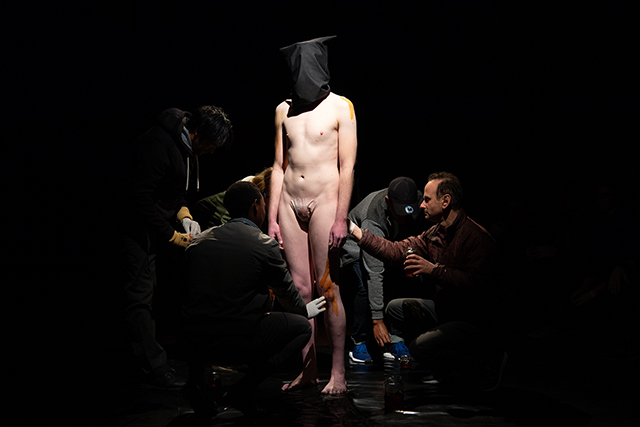Writing: Reviews & Think Pieces
Does overexposure of the black female body draw it closer to a sell-by date?
In performance or live art, the body has increasingly become an integral component for addressing complex social subjects, particularly by tackling stereotypes and legacies of representation.
When in its primal state of nudity, the body is a powerful artistic tool. There is integrity in naked flesh as an object outside blankets of pretence, “…but then nudity can be used to identify the body as a lure. Vulnerability, availability, lack of dignity or obscurity can be read into it, and this will depend on the body language of the performer…” (Howell 1999:19). But then again strength, resistance, self-worth, transparency or courage can be read into it as well, depending on the ethnicity of the performer, such as it would be on a black woman.
The black female body is constantly being used to subvert society’s interaction with it universally, the discourse through art and curatorial practice, as well as the contrived interpretation of black female sexuality. Many female performance artists use their own bodies, as strategies of liberation through social and political movements, to challenge some persisting stereotypes.
In short, concerning issues of body politics, the black female body is the most potent of weapons in the arsenal of performative arts owing to a long history of commodification, subjugation and exploitation of blackness. However, the frequency, context and proximity with which it is used alongside naked bodies of other races, blackness in various arenas complicates matters and arouses thought that the black female nude in the performative arts may run the risk of losing its potency as a weapon and could prematurely reach its sell-by date.
The black female nude body may not lose its potency as a weapon just yet, owing to the inherently voyeuristic nature of humans. Because of its “salacious appeal edging interpretation towards a discussion of fleshy historical commodification” (Viveros-Fauné 2001), it will remain a pleasurable spectacle not unlike the strip shows at the Royal Park VIP Gentlemen's Club or The Summit Club in Hillbrow, Johannesburg. In performance art “…for a woman particularly, the removal of clothing leads ultimately to the cliché of striptease… and not only in male eyes.” (Howell 1999).
If this year’s National Arts Festival hosted in Makhanda (Grahamstown) is anything to go by, nudity has in general fallen on fertile ground, with various artistes applying it in different contexts to address numerous personal and social issues. Three most notable performances were Exploitation! by artist and lecturer Heidi Sincuba, Black Privilege by award-winning choreographer and performance artist Namela Nyamza and Yet to Be Determined by critically acclaimed performance artist Gavin Krastin.
Sincuba’s Exploitation! at The Studio Gallery, Rhodes Fine Art Department, featured a series of performances rendered as videos in which she was nude. She also staged a series of live performances alongside a male collaborator, Cape Town-based artist Sizo Mahlangu, outside the gallery. It was something akin to Marina Abramovic’s 1977 Imponderabilia. Abramovic, together with her partner, Ulay, both stood at the opposite sides of a public doorway completely naked, forcing visitors to squeeze in between them in order to pass through. Whereas the purpose of Abramovic’s performance was said to be an “exploration of human physical limits and psychological reactions, obtained through the artists’ live presence in real time”, Sincuba’s aimed to “explore the everyday alchemy taken towards healing and resistance from the current ideological condition”. In the exhibition, the artist observed their substance as being “consumed callously by whiteness and patriarchy”; this was also described as confronting “concealed brutality”.
Nyamza’s aptly titled performance, Black Privilege, “was informed by the notion and experience of rejection/decline of the other by the mainstream gate-keeping institutions”, as suggested in the 2018 National Arts Programme. Themes of patronage, patronisation and hypocrisy were weaved into the performance. It was also influenced by the ‘#metoo’ movement in a South African context and sought to “show the hypocritical judgement provided by those who are quick to point out flaws but who are themselves not perfect”. The performance paid homage to the rejected, unsung and misjudged heroines of the creative industry. Painted bronze and sitting on the vantage point of a towering bronze staircase, Nyamza bore a goddess-like aura in this performance. For most of the performance, she literally looked down on the audience, playing out into a very persuasive depiction of re-claiming power.
Through remarkable execution, Sincuba and Nyamza use their black female bodies and nudity to make very strong and valid points through exceptionally entertaining and courageous performances. Nevertheless, is the potency of their performance not questionable when they share a level field with Krastin, a young white male who uses his own body and nudity as a device in a corresponding manner?
Krastin’s Yet to Be Determined described as “a visual and performative meditation on irrevocable change. Encroaching slowly and enveloping completely, as if being reminded of our smallness gives us absolute ground”, was an interactive piece where the audience had to smear his naked body with treacle (uncrystallised syrup) and later fire confetti guns filled with rainbow-filled glitter at him.
This smearing of treacle can in one reading be interpreted as an anointing, an endorsement. Was the audience therefore not anointing his white body in approval? Could it not also be read as whitewashing of the white body? A body similar to the ones owned by the privileged Anglo-Saxons, who some 300 years ago invented a system of classifying the black female body as inferior. A system that would culminate into situations such as the “parading of the nude body of Sarah Baartman … to racially categorise her as a subhuman. Her Black body was viewed as something that can be violated, exploited, destructed, penetrated, and subjugated to various inhumane conditions.” (Mothoagae 2016).
Baartman, an undoubtedly iconic historical figure, has had artists such as Sincuba and Nyamza root their artistic contentions on her legacy. If, therefore, artists such as Sincuba and Nyamza use nudity to re-claim the dignity of the black female body, is their claim then not delegitimized by sharing an arena with the likes of Krastin?
If the aforementioned does not weaken the potency of the black female body and by extension its bareness as a critical medium, seeing nudity repeatedly at short intervals over a ten-day period at the most recent National Arts Festival surely might. Overexposure may have the tendency to vulgarize even the most worthy of causes; it is one thing to take your clothes off in the name of art and frame the act in whichever manner, while it is another to do so before casual observers without the slightest understanding of stilted art-speak and lofty critical theory. It is just nudity.
~ ENDS ~
References:
Howell, A. 1999. The Analysis of Performance Art, Hardwood Academic Publishers
Mario Carbone – Posto Fisso. Marina Abramovic e Ulay a Bologna, 1977, http://www.neromagazine.it/n/?p=7943#more-7943
Mothoagae, I.D. 2016. Reclaiming our black bodies: reflections on a portrait of Sarah (saartjie) Baartman and the destruction of black bodies by the state, Department of Biblical and Ancient Studies, University of South Africa.
National Arts Festival Programme, Grahamstown, 28 June – 8 July, 2018.
Viveros-Fauné, C. 2001. Requiems for the Heavyweights: Race, Representation and Universality in the Art of Godfried Donkor, in Hassan, M. S. and Oguibe, O. (eds.) Authentic/Ex-centric: Conceptualism in Contemporary African Art

Gavin Krastin in Yet to be Determined, 2018, Photo by Jan-Potgieter
.jpg)
Heidi Sincuba, Exploitation! 2018, video still, (source National Arts Festival)

Mamela Nyamza, Black Privilege, 2018. Photo - Chris DeBeer
Andrew Mulenga is a PhD candidate with the NRF/DST SARChI Chair Geopolitics and the Arts of Africa, Arts of Africa and Global Souths research programme headed by Prof Ruth Simbao at the Department of Fine Arts, Rhodes University, South Africa
Last Modified: Tue, 02 Apr 2019 08:45:08 SAST
